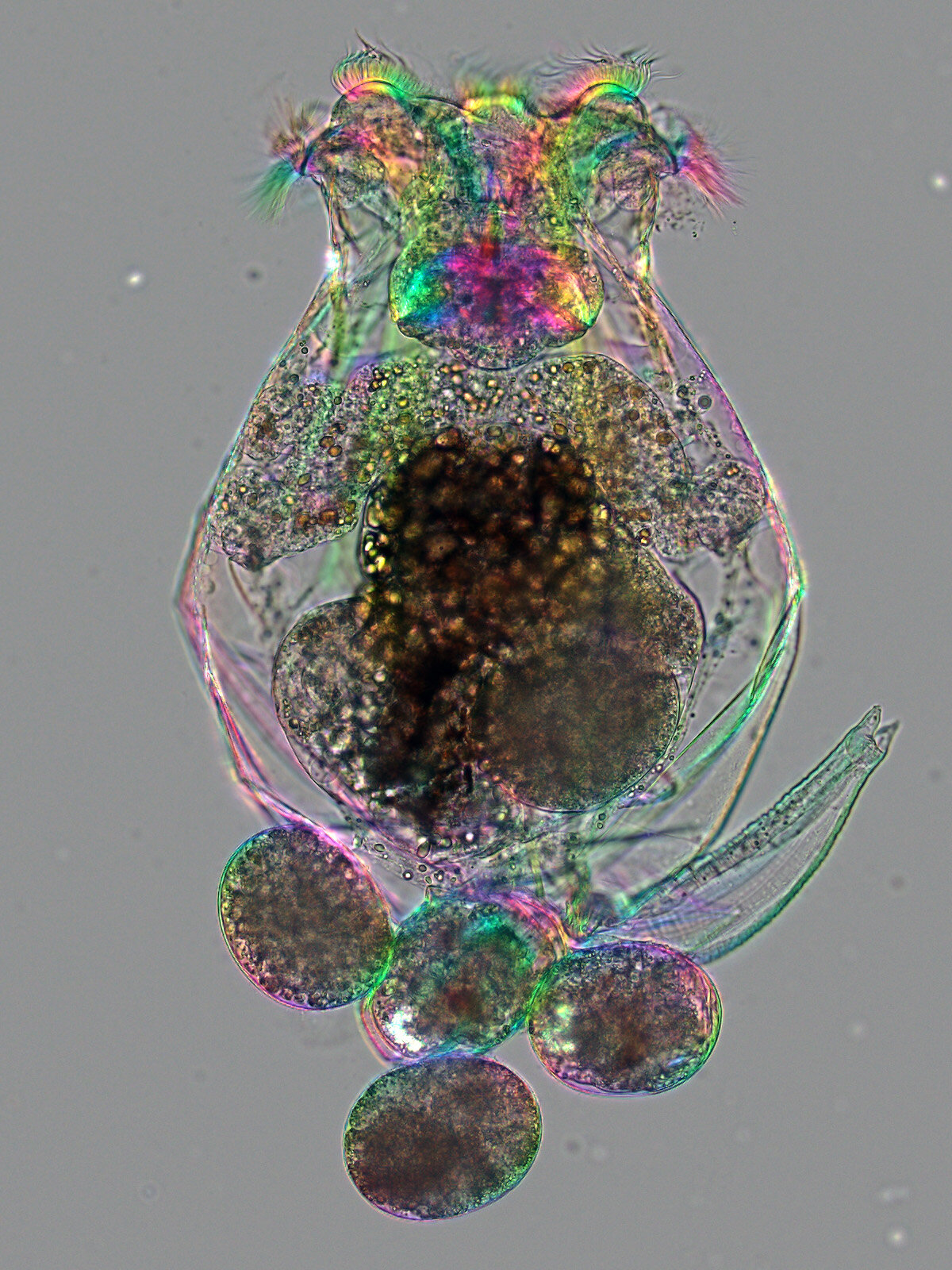A female Brachionus manjavacas rotifer, magnified under a microscope, is an intriguing subject for study. Measuring 350 µm in length, about the size of a grain of sand, this rotifer possesses hair-like cilia at its top, which it uses for swimming and feeding. By injecting the components of the CRISPR system into the female’s reproductive system, specifically targeting the genes in the four developing eggs she carries at her posterior end, we can edit those genes. These eggs will hatch within a day, and the edited genes will be carried by the offspring. The image captured using a polychromatic polarizing microscope provides a colorful view of this transparent animal. (Image credit: Michael Shribak and Kristin Gribble)
Rotifers, despite their microscopic size, offer a wealth of possibilities as study subjects. Their transparency allows easy observation under a microscope, and they thrive in laboratory cultures, providing researchers with a unique perspective on the animal kingdom. However, manipulating the genetics of rotifers has been a challenge until now, limiting the potential experiments with these creatures. Scientists Kristin Gribble and David Mark Welch of the Marine Biological Laboratory (MBL) have successfully addressed this challenge by developing a method to precisely alter rotifers’ genomes using the revolutionary gene editing technology CRISPR-Cas9. In their experiments published in PLOS Biology, they edited two genes and introduced a genetic sequence that resulted in inheritable changes in the rotifers.
“Our method offers a practical approach for generating a large number of genetically altered rotifers quickly,” said Mark Welch, a senior scientist at MBL and the director of the Josephine Bay Paul Center for Comparative Molecular Biology and Evolution. This advancement not only benefits their own lab and Gribble’s lab, where they study aging, DNA repair mechanisms, and other fundamental questions using rotifers, but it also opens up opportunities for more researchers to work with these fascinating creatures.
Rotifers have the potential to become model organisms for scientific research, but their genomes need to be altered for this purpose. In 2017, the MBL Interim Director Melina Hale provided funding for Gribble and Mark Welch to develop a method using CRISPR-Cas9 to manipulate rotifer genomes. This initiative later became known as MBL’s New Research Organisms, aiming to expand the variety of model organisms available for scientific study. CRISPR-Cas9, known for its precise DNA cutting abilities, is now used to deactivate or modify genes. However, the challenge lied in delivering the CRISPR system to the rotifers, which move rapidly in water like tiny particles.
To overcome this challenge, Haiyang Feng, the first author of the study and a former postdoctoral scientist at MBL, devised a solution. He immersed the rotifers in a high-viscosity solution and administered a low dose of an anesthetic, slowing down their movement. This allowed him to capture each individual rotifer with light suction through a hollow needle. Once immobilized, he injected the gene editing system into the part of the rotifer’s body that supplies nutrients to the eggs. The resulting offspring inherited the mutations and passed them on to subsequent generations. Using this method, the team successfully inactivated the vasa gene, which is vital for animal development, causing the rotifers to stop reproducing after a few generations. They also deactivated the mlh3 gene, preventing the production of male offspring, and introduced a section of genetic code containing “stop” instructions into mlh3, achieving the same outcome.
The CRISPR-based method developed by Gribble and Mark Welch will be utilized in their own research. Gribble, an associate scientist at MBL, is investigating the impact of maternal age on the traits of offspring and plans to explore the role of mitochondria, the energy-producing organelles within cells, by tagging or modifying them. Mark Welch intends to use the method to study the molecular mechanisms behind a particular rotifer species’ ability to revive after complete desiccation, focusing on how they repair their damaged DNA. These newfound possibilities for rotifer research are just the beginning.
Gribble believes, “This new tool, along with the ease of raising rotifers in the lab, will make it possible to use them to answer lots of questions we aren’t even thinking about yet.” The potential for further discoveries and insights into the biology of rotifers and their implications for evolution and development is immense.
More information:
Haiyang Feng et al. Highly efficient CRISPR-mediated gene editing in a rotifer, PLOS Biology (2023). DOI: 10.1371/journal.pbio.3001888
Provided by: Marine Biological Laboratory
Citation:
“Powerful gene editing approach boosts rotifers in pantheon of laboratory animals” (2023, August 4) Retrieved August 4, 2023, from https://phys.org/news/2023-08-powerful-gene-approach-boosts-rotifers.html
Denial of responsibility! TechCodex is an automatic aggregator of the all world’s media. In each content, the hyperlink to the primary source is specified. All trademarks belong to their rightful owners, and all materials to their authors. For any complaint, please reach us at – [email protected]. We will take necessary action within 24 hours.

Jessica Irvine is a tech enthusiast specializing in gadgets. From smart home devices to cutting-edge electronics, Jessica explores the world of consumer tech, offering readers comprehensive reviews, hands-on experiences, and expert insights into the coolest and most innovative gadgets on the market.


